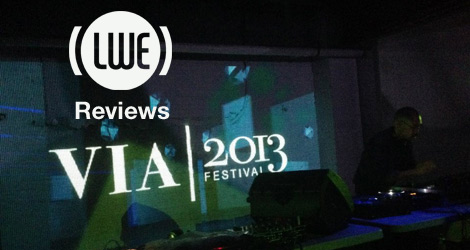
The 2013 VIA Festival took place October 1st through 6th in Pittsburgh, Pennsylvania and once again used Pittsburgh as a canvas to showcase emerging trends in music, art, and technology. While the dance music scene has grown in popularity in Pittsburgh in the past few years, particularly as some Pittsburgh artists have gained popularity outside of the city, the scene is still often insular. VIA festival thrives and grows year after year because it gets out of the bubble and attracts a wider audience to join in on the fun.
Pittsburgh is a city that forcibly reinvented itself after the shuttering of the steel mills. One of the most prominent features of Pittsburgh’s new identity is the world-class universities. Students come from all over the world to go to school in Pittsburgh, but many never put down roots in Pittsburgh, leaving quickly after graduation without seeing all of the culture the city has to offer. One of the things VIA did really well for the 2013 festival was reach out to the universities, particularly with their involvement in Carnegie Mellon, and getting students to come out to these events. All of the main VIA events were 18 and up, which also helped get students out en masse. Based on the large chunk of younger attendees at the 2013 festival, VIA connected with students interested in dancing, music, and art, and this greatly influenced the crowd of the VIA events, perhaps even helping some of these students get off of their campuses and see Pittsburgh itself a bit more.
Art + Technology
Half of the focus of the VIA festival is on the intersection of technology and art, but VIA really did their best yet at bringing the art and technology aspects into the spotlight during the 2013 festival. At the 2012 festival, the video component felt disjointed from the music. While they were happening in the same room, most of the visual artists were completely separate in what they were doing from the musicians. This year, VIA sidestepped this issue by putting the musicians on the same stage as the visual artists by constructing a projection cage around the performers. You could see through the cage and see the musicians performing, but you had to look through the video performances. Both shared the center point of the main room in the largest VIA venue, and you couldn’t experience one without the other, which made them integrate in an enjoyable way.
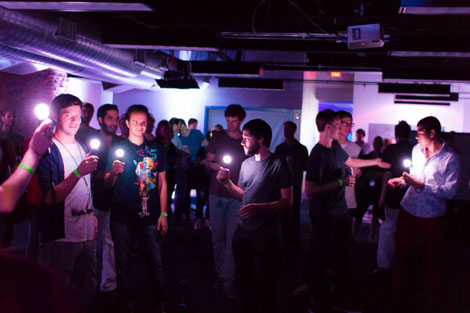
Joust, photo by Laila Elizabeth Archuleta
The main venue of VIA festival, the Family Resources Center (an unused community center in the East Liberty neighborhood of the city), used one of the rooms of the venue for a DIY technology showcase of a game called Joust. This is a motion-controller based game where the goal is to jostle the controller of your opponents and the last man standing wins. The game was an asset to VIA, and great for a music festival in general because the allowed movements are based on the speed of the music played. Whenever the music is slow, the controllers are more sensitive to movement, making it easier to jostle your opponents. When the music is fast, you can move around much more without putting yourself at risk for jostling your own controller and attack the other players. The games themselves last anywhere from 30 seconds to a few minutes, but were quick enough that everyone could play. It seamlessly integrated with the greater theme of music and technology being present and was the festival’s technological highlight.
Thursday
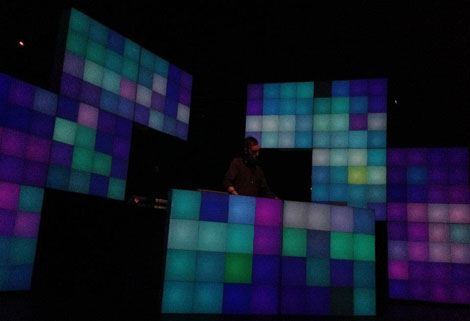
Jimmy Edgar
On Thursday, I arrived in Pittsburgh in time for the Actress and Jimmy Edgar showcase. Although the headliners have been darlings of the music press, this reviewer wasn’t well versed with much of their work. So tonight was all about the unknown, placing my faith in the VIA posse. Upon my arrival at the Rex, I was greeted with a scene that was part Minecraft and part Q*bert. Jason Burns was warming the crowd up with his tech-house sounds while people were milling about getting their drink on, taking in the outstanding Technicolor cube design of the stage.
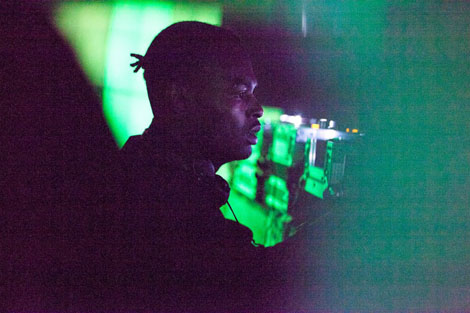
Actress, photo by Laila Elizabeth Archuleta
Jimmy Edgar was up next and the night officially went off as he did his best in keeping up the storied Detroit tradition of rocking a party for all it was worth. His mix of jack tracks, house jams, and techno highlights were exactly what the doctored ordered. Actress started his live set with some droning soundscapes that seemed to go nowhere for 45 minutes. While I’m all about texture and substance in dance music, and I would have enjoyed this set on Friday night at the Warhol with some cheese and fine white wine, but immediately after the party-rocking of Mr. Edgar, it was an odd and jarring conclusion to the evening. Unfortunately the majority of the crowd agreed with me, as people made there way home throughout his set, getting home early to rest up for the rest of the weekend’s festivities.
Friday
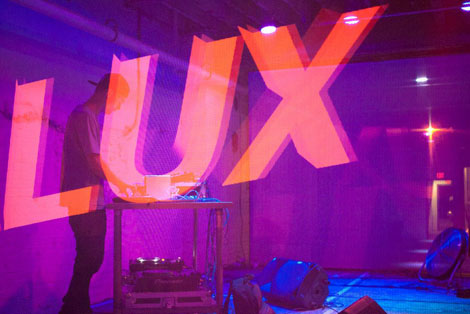
Lapalux, photo by Laila Elizabeth Archuleta
I had a bit of a late start to Friday night, but we all know the party doesn’t get started until late anyway. Unfortunately, someone forgot to tell VIA because the party was decidedly missing around 1:30 a.m. when Lapalux was playing. His set had most of the crowd swaying slightly to low-tempo, melancholic music. At times, the tracks were gritty and sleazy and even included some hard hip-hop for good measure, but it wasn’t enough to pump up the crowd at this time of night. His set would have done better when people were warming up or winding down.
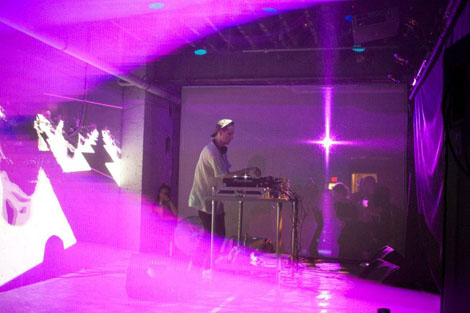
Jacques Greene
Luckily, Jacques Greene was in the house to bring the atmosphere back up into the dancing range. He started off slow to transition from the Lapalux set, but it took off from there. His set began with some funky tunes and then slid into some more solid house tracks. The energy was contagious enough that Greene himself was dancing behind his turntables during his set. DJs having fun while playing always helps the crowd out a bit too.
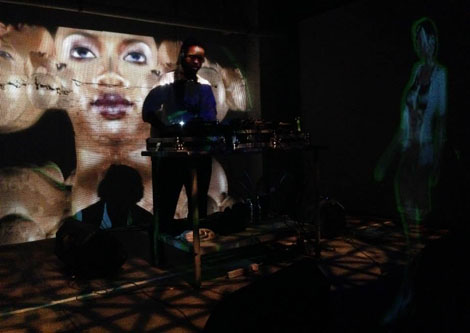
Total Freedom
In addition to playing at the CMOA gala on Friday night, Total Freedom was the one to shut down the Friday night VIA A/V showcase. The part of his set I heard before wandering off to play Joust was diverse, but had the feeling of a slower UK grime and R&B. It was a good way to step down from Jacques Greene’s performance, and it was lively enough to convince a lot of the crowd to stick around until the end of the night.
Saturday

ADULT.
The Detroit duo ADULT. blended vocals, drums, and electronic-cum-punk sounds to create their live show. The vocals were constantly (and heavily) manipulated and were generally laid over fast-paced tracks. When the female vocalist, who looked like she was straight out of “The Girl With The Dragon Tattoo,” jumped down from the stage and into the audience to sing, the crowd swarmed her, eventually looking more like a mosh pit than a dance floor.

Vessel
Next up was Vessel, which was underwhelming. The set started out slow and built up far too gradually. Instead of making everything feel gritty, which would have been great for the time of night and the venue, the sound was more like distorted noise. The crowd seemed to share my feeling as some people left to check out the other rooms of the venue while others simply left. The last performance I saw at the Saturday A/V Showcase was KiNK. His live set was uptempo, especially in comparison to Vessel’s set, which helped rescue the dance floor. He locked into a groove early on that blended house, techno, and funk. Unfortunately he was fighting an uphill battle against a sluggish audience which dwindled far earlier than it should have at 2:00 a.m., which is a shame.
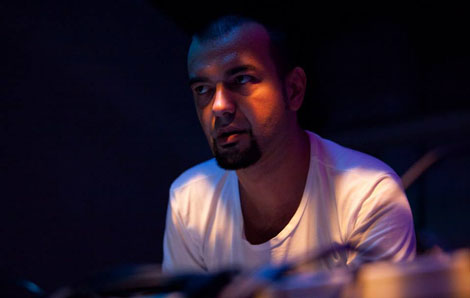
KiNK, photo by Laila Elizabeth Archuleta
The VIA afterparty on Saturday night coincided with the monthly gay party Honcho, held at the Pittsburgh Club. The venue is hidden near downtown Pittsburgh and holds around 150 people. Thankfully, the club hit capacity just a few people after I arrived, and the room was dancing hard to disco and house tunes spun by Pittsburgh local Ed Um. Chicago duo Men’s Room were the headliners, and they embraced the spot wholeheartedly, prompting the men in the room to mimic the pair’s shirtless state. The dance floor, lit mostly by a wall of LED lights, was packed such that you couldn’t have danced by yourself if you wanted to.
Sunday

The May Day Marching Band, photo by Laila Elizabeth Archuleta
The final day of VIA was a perfect wind-down to the busy weekend. Held at Bayardstown Social Club, an outdoor, all-ages venue located in a warehouse district of Pittsburgh, the music started at 3:00 p.m. and went late. The weather was decidedly un-Pittsburgh-like and perfect for an outdoor closing party. I only stopped by for a bit, and saw The May Day Marching Band play. While I hadn’t considered it before, the marching band’s melding of Latin beats, dancing, and live drums and horns (Ã la a standard marching band) was the perfect choice for this daytime party. Although I couldn’t hang for very long before heading home (exhaustion is real), this was a great, chill way to end the festival.
Final Thoughts
VIA does a great job at finding diverse musicians and artists to showcase at the festival just as they are on the brink of blowing up, which keeps the lineups exciting and innovative from year to year. One of the most frustrating aspects of the festival is the disagreement in event listings depending on how you are looking at them. The information on the Facebook event pages was different from the VIA website and was different from the ticketing website. This made it harder than it should be to figure out when and where the events are going down, which could be easily avoided. Even if lineup changes happen, as is common at music festivals, reflecting those changes across all channels is a simple way to create a better experience for attendees and clear up a lot of the confusion.
VIA wants to shake things up and aims to be underground and fun in their festival schedule, but some of their scheduling choices are a bit hard to swallow. The artist pairings seemed random and could have been done in a more complimentary way. There should be more continuity between the artists’ music and their set times, so the events had a more coherent flow that kept audiences engaged.
In the end, VIA has changed a lot in the four years since it started and although each festival is markedly different from the last, VIA seems to be homing in on what works and doing it better. The appeal of VIA festival is wide because of the variety of acts represented as well as the diversity in the people attending the events. That VIA festival is a volunteer-run (100 or more people), small-budget festival, and continues to thrive from year to year, speaks volumes to the rapidly growing music landscape of Pittsburgh as well as the tenacity of the promoters themselves. I can’t wait to see how they bring it next year.












